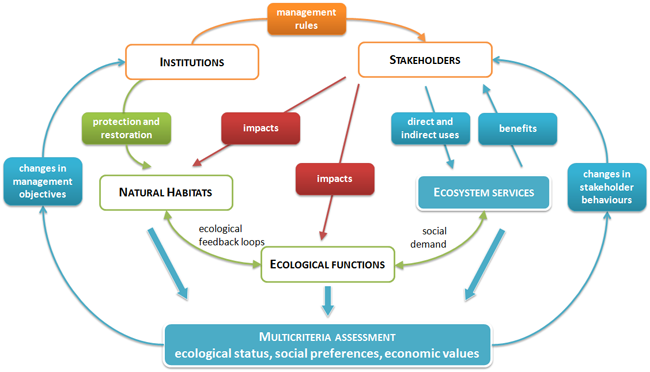1.2.5 Managing pressures and not ecosystem services

 Environmental management actions are often about regulating pressures exerted by human activities on the environment.
Environmental management actions are often about regulating pressures exerted by human activities on the environment.
Existing assessment frameworks often approach the socio-ecosystems via the pressures exerted by human activities on the ecosystems.
The causal framework DPSIR ![]() (Driving forces > Pressures > States > Impacts > Responses) adopted by the European Environment Agency is often used and has been chosen by the PEGASO European project (People for Ecosystem based Governance in Assessing Sustainable development of Ocean and coast). The European project SPICOSA Science and Policy Integration for Coastal System Assessment), chose a System Approach to support Integrated Coastal Management where the conceptual models were based on the Resource – Uses – Governance inspired by the work Economics Nobel prize Elinor Ostrom on managing common pool (finite) resources [Ostrom, 1995; Mongruel et al., 2011
(Driving forces > Pressures > States > Impacts > Responses) adopted by the European Environment Agency is often used and has been chosen by the PEGASO European project (People for Ecosystem based Governance in Assessing Sustainable development of Ocean and coast). The European project SPICOSA Science and Policy Integration for Coastal System Assessment), chose a System Approach to support Integrated Coastal Management where the conceptual models were based on the Resource – Uses – Governance inspired by the work Economics Nobel prize Elinor Ostrom on managing common pool (finite) resources [Ostrom, 1995; Mongruel et al., 2011 ].
].
'How can we manage ecosystem services? We manage human activities' (a manager from a case study site)
Conversely, the Ecosystem Services Approach focuses primarily on the benefits provided by the ecosystems, so in order to be useful to policy makers and managers, it must take into account the pressures exerted on the services and highlight the drivers of change and how a loss of service is going to impact human well-being.

Figure: A system view of ecosystem services at the local level [Mongruel et al., 2015 ]
]
The assessment or valuation must be committed to human action whether to manage pressures or to define positive actions in favour of the environment (by changing economic practices of production or promoting a change of individual behaviour). It must consider different levels in the system, raise awareness and inform decision making in order to bring about changes in regulatory objectives, sanction or incentive policies, structures and practices of governance.

